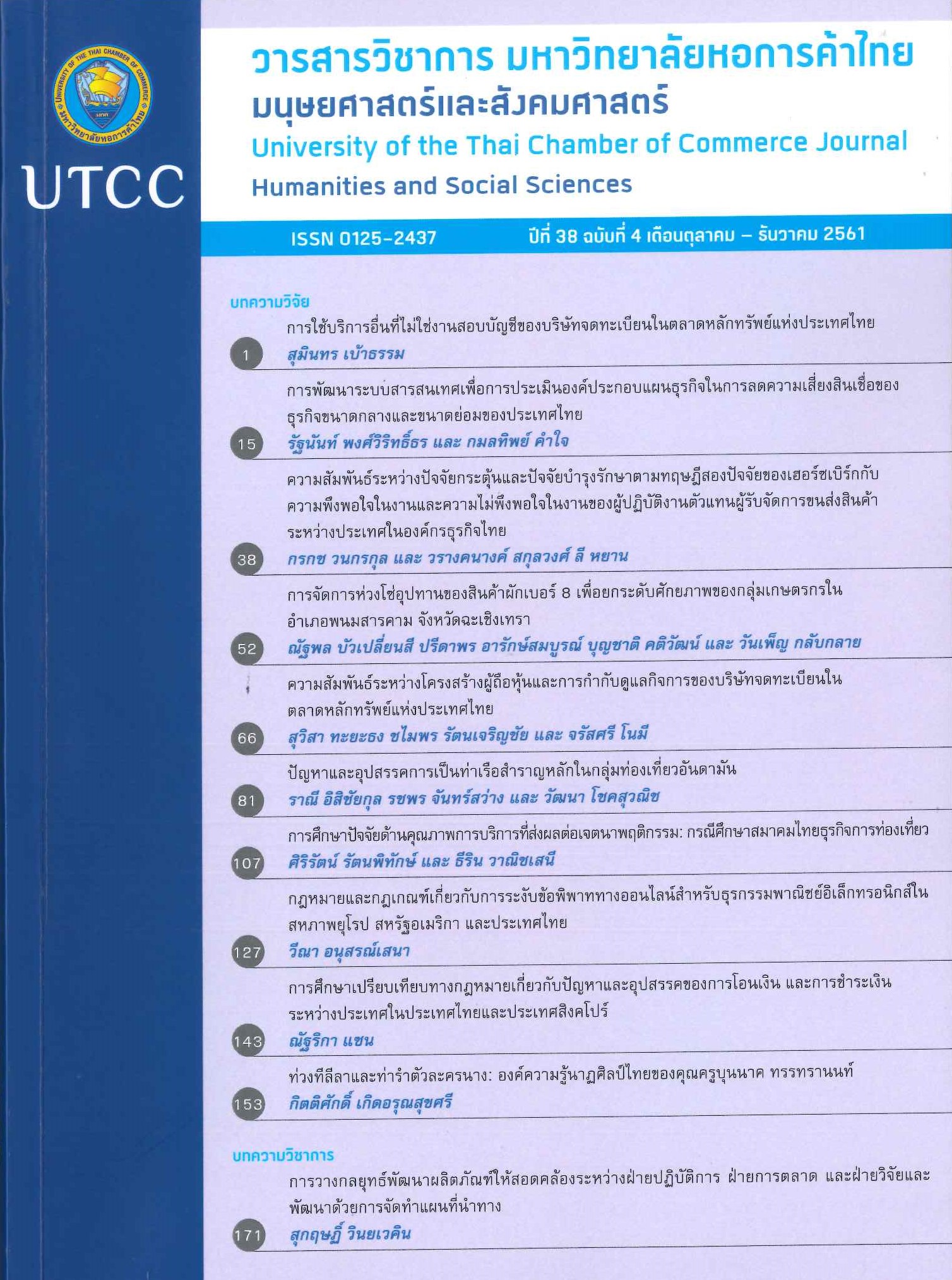Problems and Obstacles of Developing Cruise Home Port in Andaman Tourism Cluster
Main Article Content
Abstract
The purposes of this research were (1) to study contexts of cruise tourism in Thailand and Andaman Sea; (2) to investigate problems and obstacles of cruise home port development; and (3) to propose key success factors of how to solve problems of a cruise home port in Andaman Tourism Cluster of Thailand. This research was a qualitative research. Population were stakeholders related to cruise tourism of public sector, private sector, local communities, and academic experts in the central and the southern region. Twenty-seven interviews were conducted through purposive sampling from related key informants from September 2016 to April 2017. For qualitative data analysis, content analysis was used to analyze data. The results showed that (1) Thailand has been a cruise destination for more than thirty years as a port of call of many cruise ships. Those cruise ships brought passengers into Thailand as day trippers. Most cruise ships arrived in the morning when passengers disembarked cruise ships and they embarked back in the evening while the ships would sail to the next port. At present, Thailand has only one cruise terminal at Laem Chabang Port to use as a port of call and turnaround port for cruise passengers, but the facility development and management is not fully efficient for accommodating large cruise ships. Thailand has five cruise service ports in which anchoring at Patong beach and docking at Phuket Deep Sea Port is the most popular landing pier. Phuket was
chosen as one of the ports of call continuously in Andaman Sea because of the development of Singapore cruise homeports and the short-distance cruise route between various connectingports and Phuket. (2) The result of problems and obstacles of home port development in Andaman Tourism Cluster included limitation of port infrastructure, non-standardized existing ports, limited government policy, lack of corporation among stakeholders, lack of resources for serving tourists during high season, in-efficient local transport, lack of competent personnel, a local ship’s tender, and environmental impact. (3) The research findings lead to develop some guidelines for key success factors for the public sector, private sector and the communities for developing cruise home ports, together with cooperation among all stakeholders.
Article Details
ลิขสิทธิ์ของบทความ
ผลงานที่ได้รับการตีพิมพ์ถือเป็นลิขสิทธิ์ของมหาวิทยาลัยหอการค้าไทย ห้ามมิให้นำเนื้อหา ทัศนะ หรือข้อคิดเห็นใด ๆ ของผลงานไปทำซ้ำ ดัดแปลง หรือเผยแพร่ ไม่ว่าทั้งหมดหรือบางส่วนโดยไม่ได้รับอนุญาตเป็นลายลักษณ์อักษรจากมหาวิทยาลัยหอการค้าไทยก่อน
References
จาก https://www.thaicruise.trm.com/
กระทรวงมหาดไทย. (2558). โครงการสัมมนาเชิงปฏิบัติการเพื่อขับเคลื่อนยุทธศาสตร์เชื่อมโยงการพัฒนาความร่วมมือด้านการท่องเที่ยวทางทะเล ภายใต้แผนงานการพัฒนาเขตเศรษฐกิจสามฝ่ายอินโดนีเซีย มาเลเซีย ไทย,3-4 กรกฎาคม 2558.กรุงเทพฯ: ผู้แต่ง.
จุมพล ชฎาวัฒน์. (2558). ภาคธุรกิจเรือท่องเที่ยวสำราญ: โครงการสัมมนาเชิงปฏิบัติการเพื่อขับเคลื่อนยุทธศาสตร์เชื่อมโยงการพัฒนาความร่วมมือด้านการท่องเที่ยวทางทะเล ภายใต้แผนงานการพัฒนาเขตเศรษฐกิจสามฝ่ายอินโดนีเซีย มาเลเซีย ไทย, 3-4 กรกฎาคม 2558. กรุงเทพฯ: กระทรวงมหาดไทย.
ธัชไท กีรติพงศ์ไพบูลย์ (2558). ภาครัฐกับการท่องเที่ยวสำราญ: โครงการสัมมนาเชิงปฏิบัติการเพื่อขับเคลื่อนยุทธศาสตร์เชื่อมโยงการพัฒนาความร่วมมือด้านการท่องเที่ยวทางทะเล ภายใต้แผนงานการพัฒนาเขตเศรษฐกิจสามฝ่ายอินโดนีเซีย มาเลเซีย ไทย, 3-4 กรกฎาคม 2558. กรุงเทพฯ: กระทรวงมหาดไทย.
บุญเสริม ขันแก้ว. (2558). ภาครัฐกับการท่องเที่ยวสำราญ: โครงการสัมมนาเชิงปฏิบัติการเพื่อขับเคลื่อนยุทธศาสตร์เชื่อมโยงการพัฒนาความร่วมมือด้านการท่องเที่ยวทางทะเล ภายใต้แผนงานการพัฒนาเขตเศรษฐกิจสามฝ่ายอินโดนีเซีย มาเลเซีย ไทย, 3-4 กรกฎาคม 2558. กรุงเทพฯ: กระทรวงมหาดไทย.
ไพฑูรย์ มนต์พานทอง. (2558). การพัฒนาการท่องเที่ยวเรือสำราญของประเทศไทย. กรุงเทพฯ: การท่องเที่ยวแห่งประเทศไทย.
ไพฑูรย์ มนต์พานทอง. (2560). การวิเคราะห์องค์ประกอบการจัดการท่าเรือแบบผสมกับบริบทการท่องเที่ยวเรือสำราญ.วารสารการจัดการ มหาวิทยาลัยวลัยลักษณ์ , 6(3): 107 - 124.
ไพฑูรย์ มนต์พานทอง และเทิดชาย ช่วยบำรุง. (2558). ผลการปฏิบัติงานการจัดการท่าเรือแวะพักของจังหวัดภูเก็ต สำหรับการท่องเที่ยวเรือสำราญ: การประเมินผลโดยการใช้การวิเคราะห์ความสำคัญและผลการปฏิบัติงาน.วารสารการจัดการ มหาวิทยาลัยวลัยลักษณ์, 4(1): 1-11.
เรือสำราญภูเก็ตวอนรัฐทำท่าเรือน้ำลึกหนุนท่องเที่ยว. (2555, 15 กรกฎาคม).ไทยรัฐออนไลน์ สืบค้นจาก https://www.thairath.co.th/content/276247
วัฒนา โชคสุวณิช (2558). ภาคธุรกิจเรือท่องเที่ยวสำราญ. โครงการสัมมนาเชิงปฏิบัติการเพื่อขับเคลื่อนยุทธศาสตร์เชื่อมโยงการพัฒนาความร่วมมือด้านการท่องเที่ยวทางทะเล ภายใต้แผนงานการพัฒนาเขตเศรษฐกิจสามฝ่ายอินโดนีเซีย มาเลเซีย ไทย, 3-4 กรกฎาคม 2558. กรุงเทพฯ: กระทรวงมหาดไทย .
ASEAN. (2002). The Study for an Integrated Regional Cooperation Framework Plan. ASEAN Cruise Development Framework. Retrieved April 10, 2016 from https://www.asean.org/uploads/archive/ACDF-Report.pdf
Chen, C. A. (2016). How can Taiwan create a niche in Asia's cruise tourism industry? Tourism Management, 55, 173-183.
Cruise Lines International Association. (2015). 2015 Cruise Industry Outlook: Cruising to New Horizons and offering traveler more. Retrieved April 10, 2016 from https://www.cruising. org/docs/default-source/research/2015-cruise-industry-outlook.pdf
Cruise Lines International Association. (2018). Asia Cruise Trends 2018 Edition. Retrieved October 10, 2018 from https://safety4sea.com/wp-content/uploads/2018/07/CLIA-Asia-Cruise-Trends-2018-Edition-2018_07.pdf
Demetriou, I. (2011). The Promotion of the New Larnaka Port as a Homeport for Cruises in the Wider Region of Eastern Mediterranean: Challenges, Perspectives and Specific Proposals. Maritime Institute of Eastern Mediterranean.
Dowling, K. R. 2006. Cruise Ship Tourism. London, England: CAB international.
Gibson, P. (2006). Cruise operations management. New York: Routledge.
Hsu, C.H.C.(2015). Competitive landscape of Asian cruise ports. October 10, 2018, from https://scholarworks.umass.edu/cgi/viewcontent.cgi referer=https://www.google.com/&httpsredir=1&article=1122&context=ttra
Kizielewicz, J. (2012). Theoretical considerations on understanding of the phenomenon of maritime tourism in Poland and the world. Scientific Journals,31(103)
Lekakou, M.B., Pallis, A.A., & Vaggelas, G.K. (2009). Which homeport in Europe: The cruise industry’s selection criteria. Tourismos: An International Multidisciplinary Journal of Tourism, 4(4): 215-240.
Liu, X. M. (2006). Customer relationship management in Asia/Pacific cruise industry (Unpublished doctoral dissertation). University of Nottingham.
McCalla, R.J. (1998) An investigation in to site and situation: Cruise ship port. Voor Economische en Sociale Geografie, 89(1): 44-55.
Morgan, P., & Power, L. (2011). Cruise tourism and the cruise industry. In P. Robinson, S. Heitmann, & P. Dieke (Eds.), Research themes for tourism (pp.276-288). Cambridge, MA:CAB International.
Pavlic, I. (2013). Cruise tourism demand forecasting- the case study of Dubrovnik. Tourism and Hospitality Management,19 (1), 125-142.
Policy Rasearch Corporation. (2009). Tourist facilities in ports: The economic factor. Antwerp, Belgium: Author.
Rodrigue, J. P., & Notteboom, T. (2012). The cruise industry: itineraries, not destinations. Port Technology International, 54,13-16.
TEC Inc. (2007) /Port of Sydney master plan.. Andover, MA: Author.
Wang, Y., Jung, K.A., Yeo, G. T., & Chou, C.C. (2014). Selecting a cruise port of call location using the fuzzy-AHP method: case study in East Asia. Tourism Management, 42, 262-270.
World Tourism Organization. (2010). Cruise tourism - current situation and trends. Retrieved April 10,2016, from https://pub.unwto.org/WebRoot/Store/Shops/ In foshop/4860/F69B/DDF8/6297/2C04/C0A8/0164/E2F3/110111_ceuise_tourism_excerpt.pdf.
World Travel and Tourism Council, (2004). The Caribbean: The impact of travel & tourism on jobs and the economy.London, England: Author.


